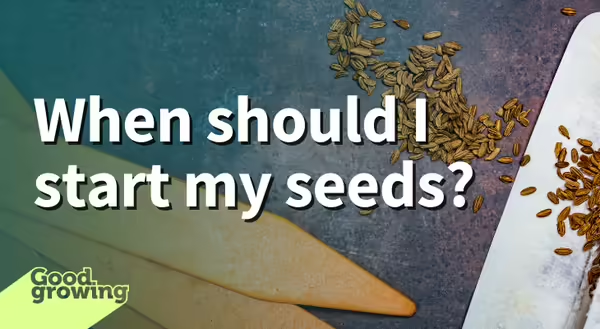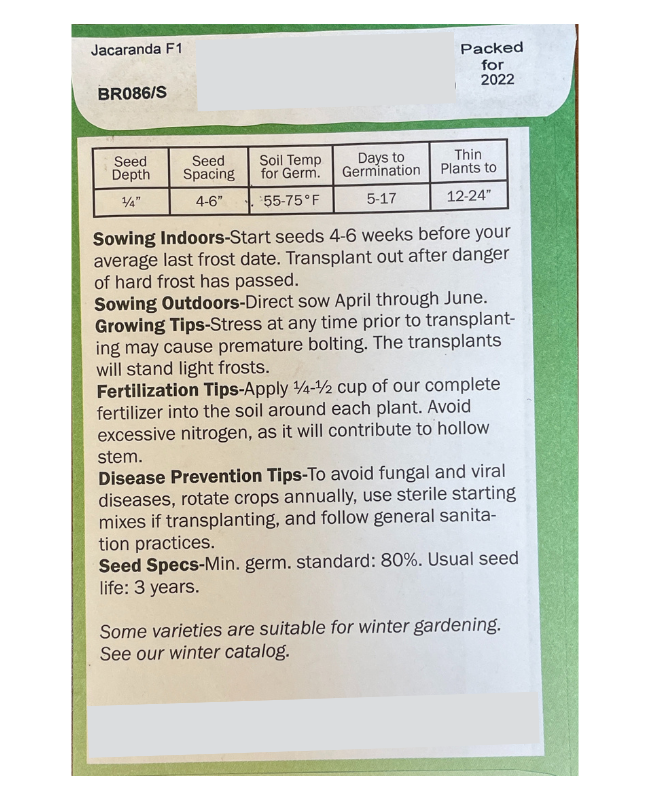
Seed starting is a great way to scratch the gardening itch we often get during late winter. In addition to getting a head start on the growing season, there are a number of additional benefits to starting your own seeds.
Starting seeds to make your own transplants can be cheaper than going out and buying them later in the year. You also have much more variety to choose from when you start your own seeds compared to purchasing transplants from the store. There are hundreds of varieties compared to a handful when it comes to popular plants like tomatoes. It also allows you to grow plants you wouldn’t normally be able to find at stores, for instance, artichokes.
One common question people have is, when should I start planting my seeds indoors?
Check the seed packet
Before you get started, take some time to review your seed packets. The seed packets will provide information on whether starting your seeds indoors or out is recommended. It will also say when seeds should be started, for example, 4-6 weeks before your average last frost date. (Not sure when your average last frost date is? Check out the Illinois State Climatologist website.)
The seed packet should also provide information on how deep the seeds should be planted. They will often also include information on how many days it will take for seeds to germinate and what soil temperatures are needed for seeds to germinate best.
When should I start planting?
If you don’t feel like trying to figure out when you should start seeds, here are some general dates for starting some commonly grown vegetables, herbs, and flowers in central Illinois (the last frost is usually around early May). As a general rule, if you’re in northern Illinois, start two weeks later; in southern Illinois, start two weeks earlier.
February
- Vegetables & herbs: celery, leek, onion, parsley, rosemary, thyme
- Flowers: dianthus, foxglove, pansy/viola, verbena, lavender
Early-to-mid-March
- Vegetables & herbs: artichoke, broccoli, cabbage, cauliflower, eggplant, kale, lettuce, oregano
- Flowers: blanket flower, hibiscus, hollyhock, impatiens, petunia, salvia, snapdragon, statice
Mid-to-late March
- Vegetables & herbs: basil, parsley, pepper, Swiss chard, tomato
- Flowers: Chinese aster, celosia, bachelor’s button, cosmos, gomphrena, marigold, strawflower
Early-to-mid-April
- Vegetables & herbs: okra
- Flowers: amaranth, hyacinth bean, Tithonia
Mid-to-late April
- Vegetables & herbs: cucumber, melons, pumpkin, squash
- Flowers: Zinnia
Good Growing tip of the Week: If you want to try your hand at a fall vegetable garden, cool-season vegetables such as broccoli, cauliflower, cabbage, and kale can also be started from seed indoors in early July and planted outdoors in late July to early August.
Signup for our emails! Want to get notified when new Good Growing posts are available? SIGN ME UP
MEET THE AUTHOR
Ken Johnson is a Horticulture Educator with University of Illinois Extension, serving Calhoun, Cass, Greene, Morgan, and Scott counties since 2013. Ken provides horticulture programming with an emphasis on fruit and vegetable production, pest management, and beneficial insects. Through his programming, he aims to increase backyard food production and foster a greater appreciation of insects.
